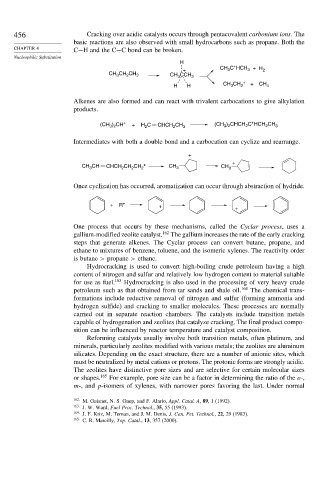Page 475 - Advanced Organic Chemistry Part A - Structure and Mechanisms, 5th ed (2007) - Carey _ Sundberg
P. 475
456 Cracking over acidic catalysts occurs through pentacovalent carbonium ions. The
basic reactions are also observed with small hydrocarbons such as propane. Both the
CHAPTER 4 C−H and the C−C bond can be broken.
Nucleophilic Substitution
H
+
+ CH C HCH + H 2
3
3
CH 3 CH 2 CH 3 CH CCH 3
3
H H CH CH 2 + + CH 4
3
Alkenes are also formed and can react with trivalent carbocations to give alkylation
products.
) CHCH C HCH CH
(CH ) CH + + H C CHCH 2 CH 3 (CH 3 2 2 + 2 3
3 2
2
Intermediates with both a double bond and a carbocation can cyclize and rearrange.
+
+
CH 3 CH CHCH 2 CH CH 2 + CH 3 CH 3
2
Once cyclization has occurred, aromatization can occur through abstraction of hydride.
+ R + +
+
One process that occurs by these mechanisms, called the Cyclar process, uses a
gallium-modified zeolite catalyst. 162 The gallium increases the rate of the early cracking
steps that generate alkenes. The Cyclar process can convert butane, propane, and
ethane to mixtures of benzene, toluene, and the isomeric xylenes. The reactivity order
is butane > propane > ethane.
Hydrocracking is used to convert high-boiling crude petroleum having a high
content of nitrogen and sulfur and relatively low hydrogen content to material suitable
for use as fuel. 163 Hydrocracking is also used in the processing of very heavy crude
petroleum such as that obtained from tar sands and shale oil. 164 The chemical trans-
formations include reductive removal of nitrogen and sulfur (forming ammonia and
hydrogen sulfide) and cracking to smaller molecules. These processes are normally
carried out in separate reaction chambers. The catalysts include transition metals
capable of hydrogenation and zeolites that catalyze cracking. The final product compo-
sition can be influenced by reactor temperature and catalyst composition.
Reforming catalysts usually involve both transition metals, often platinum, and
minerals, particularly zeolites modified with various metals; the zeolites are aluminum
silicates. Depending on the exact structure, there are a number of anionic sites, which
must be neutralized by metal cations or protons. The protonic forms are strongly acidic.
The zeolites have distinctive pore sizes and are selective for certain molecular sizes
or shapes. 165 For example, pore size can be a factor in determining the ratio of the o-,
m-, and p-isomers of xylenes, with narrower pores favoring the last. Under normal
162
M. Guisnet, N. S. Gnep, and F. Alario, Appl. Catal. A, 89, 1 (1992).
163 J. W. Ward, Fuel Proc. Technol., 35, 55 (1993).
164 J. F. Kriz, M. Ternan, and J. M. Denis, J. Can. Pet. Technol., 22, 29 (1983).
165
C. R. Marcilly, Top. Catal., 13, 357 (2000).

